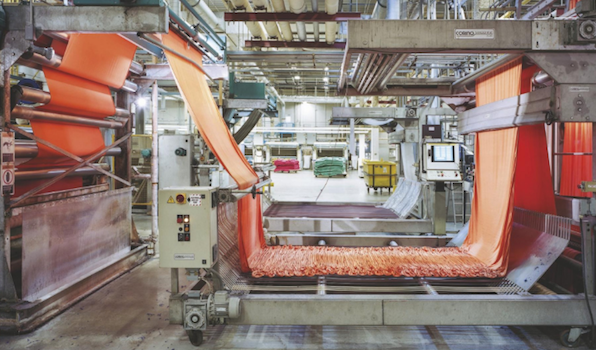
Made In The USA

While we all wear clothes manufactured in factories and mills, we rarely see the inside of these industrial spaces. Having trained as an architect and self-taught in photography, Chris Payne has gone on to explore the textile industry in America. Although Chris’s photographs have a relation to architectural drawings, with each image meticulously capturing mechanical processes and details, they are also painterly in the way that movement and colour play key roles. In Selvedge issue 75, Chris tells us a little bit about these secret textile worlds…

What led you to the textile industry?
When I discovered an old yarn mill in 2010, tucked away in a sleepy hamlet in Maine, I had no idea it would turn into a long-term project. I returned to the mill several times, and from conversations with employees, learned of other textile factories in the northeast. Since then I have gained access to an industry that symbolises, more than any other, the decline of traditional manufacturing in the United States. Several decades of overseas competition, unequal trade policies, and a flood of cheap imports have decimated American textile mills.

What is your approach?
The challenge of this project is to find those moments in the choreography of production that are both beautiful and informative, and worthy of a picture that will hold an outsider’s interest. I seek the intersection where art meets documentation, where the mechanical process of making a sweater becomes something poetic. More than anything, I want my work to convey the value of manufacturing and craftsmanship.

Since beginning this project I have developed a greater appreciation for how clothing is made, especially the various machines and mechanical processes of weaving and knitting, and all the intermediary steps that transform raw materials into a finished fabric. It’s like architecture and construction on a smaller scale. I’ll never look at denim the same way!

Today, most people assume this industry has vanished yet it survives, albeit on a much smaller scale, and (for the most part) out of public view. The jobs in apparel may be gone, but the modern definition of textiles is broad and encompasses much more than clothing. With last year’s presidential election, the debate over the importance of manufacturing has once again become a charged political topic. Yet few people nowadays have ever been inside a factory and have little idea what manufacturing really means. My photographs offer a view into this world, showing how one industry has evolved and transformed, and what its future may hold...
You can read this article in full in Selvedge issue 75.
